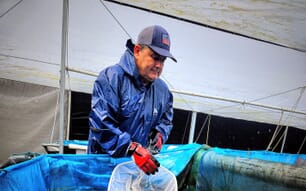The SPF was developed by Rajiv Gandhi Centre for Aquaculture, the R & D arm of the Marine Products Export Development Authority in association with the Oceanic Institute, Hawaii, USA, according to the India Education Bureau.
The primary objective of this initiative is to produce selectively bred Litopenaeus vannamei shrimp broodstock (mother shrimp) that exhibit good hatchery performance for producing high quality shrimp seed which should exhibit fast growth and high survival on commercial shrimp farms in India.
Selectively bred SPF L.vannamei also has the potential to grow under intensive culture conditions, tolerates a wide range of salinities and temperatures and only requires lower protein diet and can also utilise the natural productivity of shrimp ponds in intensive culture conditions. It is generally considered to be more resistant to diseases and can mate and spawn easily under captivity and the survival rates during hatchery rearing are generally higher.
Shrimp production can substantially contribute to marine product export from the country. During the financial year 2011-12, for the first time in the history of Marine product exports, the export earnings have crossed US$ 3.5 billion. Frozen Shrimp is the major export value item accounting for 49.63 per cent of the total US dollar earnings. One of the major reasons for the increase in production and higher export turnover was due to the introduction of SPF L.vannamei shrimp for aquaculture production.
Despite an established aquaculture industry, one of the major obstacles for increasing L.vannamei production is the non-availability of quality SPF broodstock in India in required quantities.
Currently shrimp hatcheries import L.vannamei broodstock from Broodstock Multiplication Centres in USA, Thailand and Singapore with high shipping costs and transit loss due to mortality.
The average cost of broodstock when it reaches the hatchery is estimated at Rs.5000/- and the higher cost of broodstock and transportation ultimately gets transferred to the shrimp farmers who purchase seeds at a higher price (Rs. 0.6 per seed).
High costs of broodstock is also prompting some hatcheries to source broodstock from shrimp ponds, which ultimately results in the production of poor quality seeds and subsequent crop loss to farmers.
About 80 per cent of the shrimp farmers are marginal and small scale farmers with 0.5 to 5 Ha water spread area and the success of the crop largely depends on the quality of seeds supplied to the farmers. Hence for sustaining the productivity and profitability of shrimp farmers, it is essential that quality seeds are provided to farmers at reasonable rate.
This project shall help Indian farmers to produce 1.35 lakh MT of additional shrimp for export worth around Rs. 4000 crores per annum by utilising about 10,000 Ha water spread area for two crops per annum.
Most importantly, this initiative of MPEDA will deliver quality broodstock to shrimp hatcheries and thus ensure the supply of quality seeds required for several thousands of small and marginal farmers at half the price of imported stock.




